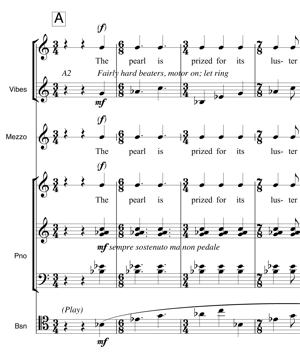The Pearl
10/1/00 for ensemble

The Text
'The pearl is prized for its luster and simplicity; the oyster is a complex living beast whose innards give rise to this mysteriously simple gem.
Gödel's Theorem appears as Proposition VI in his 1931 paper "On Formally Undecidable Propositions in Principia Mathematica and Related Systems I." It states:
To every w-consistent recursive class k of formulae there correspond recursive class-signs r, such that neither v Gen r nor Neg (v Gen r) belongs to Flg (k) (where v is the free variable of r).
Actually, it was in German, and perhaps you feel that it might as well be in German anyway. So here is a paraphrase in more normal English:
All consistent axiomatic formulations of number theory include undecidable propositions.
This is the pearl.'
Douglas R Hofstadter 'Gödel, Escher, Bach: an Eternal Golden Braid' Penguin 1979 p 17
About the text
If a belief in science and technology is in the end a matter of faith, then this is a religious text, dealing as it does with one of the most profound mathematical theories of the twentieth century.
I first came upon Douglas R Hofstadter's book 'Gödel, Escher, Bach: an Eternal Golden Braid' when I was at university, studying for a BSc in Biological Sciences. Many years later, by then a student of music, I re-read it more closely, managing almost to follow the mathematical arguments.
Gödel's 1931 theory produced a conceptual revolution in mathematics, in some ways parallel to that of relativity and quantum mechanics in physics. He demonstrated that, in essence, there was an inescapable paradox at the heart of mathematics; that 'no fixed system, no matter how complicated, could represent the complexity of the whole numbers: 0, 1, 2, 3, ...' (GEB p19). Hofstadter weaves his 'Eternal Golden Braid' around a lay-person's explanation of Gödel's proof, bringing in the music of JS Bach and the art of MC Escher, along with zen koans, artificial intelligence, genetics, Lewis Carroll, and more besides.
Notes
There have been several versions of this piece:
- Original version 10/1/2000 for mezzo-soprano, flute, clarinet in Bb, piano, harp, 2 violins, viola, violoncello: unsuccessful entry for the Britten Sinfonia competition, possibly lost
- A version performed by Invention Ensemble on 26/5/2000 for female voice, flute, clarinet, alto & tenor saxes, piano, guitar, bass
- A rearranged version for Invention Ensemble, possibly lost
- A version arranged down for mezzo soprano, vibraphone, piano and bassoon: this is the score and demo given on this page.
Duration ~4'
Demo
pearl.mp3 (3'14, 3.1 MB)